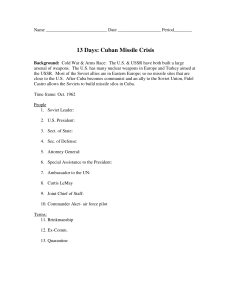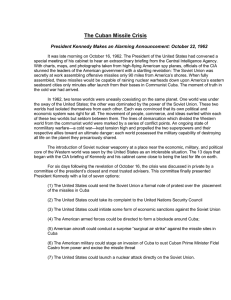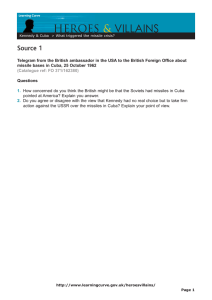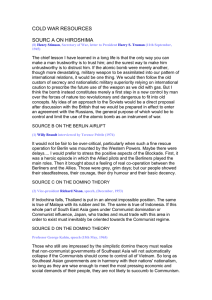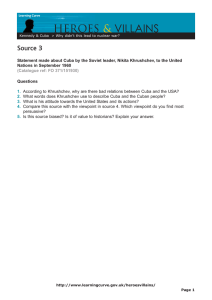THE CUBAN MISSILE CRISIS
advertisement
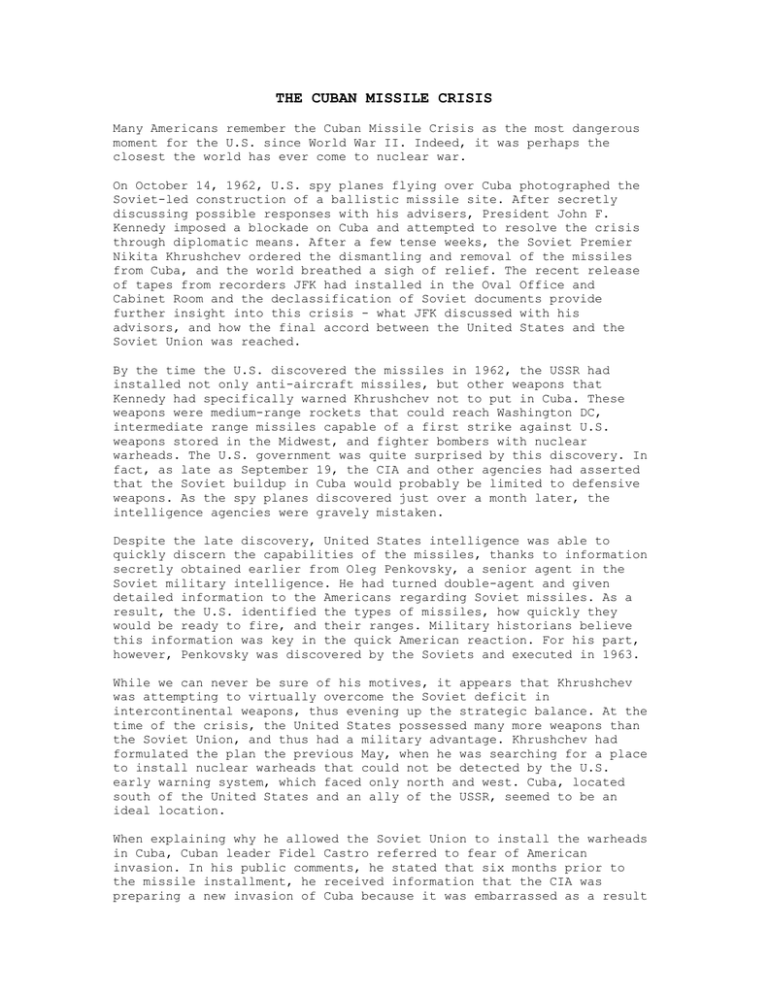
THE CUBAN MISSILE CRISIS Many Americans remember the Cuban Missile Crisis as the most dangerous moment for the U.S. since World War II. Indeed, it was perhaps the closest the world has ever come to nuclear war. On October 14, 1962, U.S. spy planes flying over Cuba photographed the Soviet-led construction of a ballistic missile site. After secretly discussing possible responses with his advisers, President John F. Kennedy imposed a blockade on Cuba and attempted to resolve the crisis through diplomatic means. After a few tense weeks, the Soviet Premier Nikita Khrushchev ordered the dismantling and removal of the missiles from Cuba, and the world breathed a sigh of relief. The recent release of tapes from recorders JFK had installed in the Oval Office and Cabinet Room and the declassification of Soviet documents provide further insight into this crisis - what JFK discussed with his advisors, and how the final accord between the United States and the Soviet Union was reached. By the time the U.S. discovered the missiles in 1962, the USSR had installed not only anti-aircraft missiles, but other weapons that Kennedy had specifically warned Khrushchev not to put in Cuba. These weapons were medium-range rockets that could reach Washington DC, intermediate range missiles capable of a first strike against U.S. weapons stored in the Midwest, and fighter bombers with nuclear warheads. The U.S. government was quite surprised by this discovery. In fact, as late as September 19, the CIA and other agencies had asserted that the Soviet buildup in Cuba would probably be limited to defensive weapons. As the spy planes discovered just over a month later, the intelligence agencies were gravely mistaken. Despite the late discovery, United States intelligence was able to quickly discern the capabilities of the missiles, thanks to information secretly obtained earlier from Oleg Penkovsky, a senior agent in the Soviet military intelligence. He had turned double-agent and given detailed information to the Americans regarding Soviet missiles. As a result, the U.S. identified the types of missiles, how quickly they would be ready to fire, and their ranges. Military historians believe this information was key in the quick American reaction. For his part, however, Penkovsky was discovered by the Soviets and executed in 1963. While we can never be sure of his motives, it appears that Khrushchev was attempting to virtually overcome the Soviet deficit in intercontinental weapons, thus evening up the strategic balance. At the time of the crisis, the United States possessed many more weapons than the Soviet Union, and thus had a military advantage. Khrushchev had formulated the plan the previous May, when he was searching for a place to install nuclear warheads that could not be detected by the U.S. early warning system, which faced only north and west. Cuba, located south of the United States and an ally of the USSR, seemed to be an ideal location. When explaining why he allowed the Soviet Union to install the warheads in Cuba, Cuban leader Fidel Castro referred to fear of American invasion. In his public comments, he stated that six months prior to the missile installment, he received information that the CIA was preparing a new invasion of Cuba because it was embarrassed as a result of the botched 1961 invasion at the Bay of Pigs. In addition, JFK had recently reminded the Soviets that the United States had not intervened when the Warsaw Pact (led by the USSR) invaded Hungary in 1956. According to Castro, this reminder indicated that Kennedy was asking for Russian non-intervention in the event of an American invasion of Cuba. Pooling their information, Cuba and the USSR concluded that the U.S. was possibly planning an invasion. Castro then asked Khrushchev to convince the United States that an attack on Cuba would be equivalent to attacking the Soviet Union. The USSR, wanting to preserve the honor of a fellow socialist country, decided that installing missiles was the best course of action. Once he knew of the missiles, JFK began secret discussions with his advisers to decide how the U.S. should react. The possible reactions ranged from invasion to air strikes to a blockade or diplomacy. According to Defense Secretary Robert S. McNamara, a majority of the President's advisers were ready to bomb the missile sites and invade if Khrushchev did not remove the missiles soon. In fact, some of these advisers estimated that the odds of a nuclear war were at 35-50 percent. Kennedy, on the other hand, took a less hawkish approach. He feared that if the Americans bombed Cuba, the Soviets would react and take Berlin (Berlin was split into the democratic west sector and the Communist east sector), possibly triggering a nuclear war. JFK tried to balance the U.S. credibility as the leader of the anti-Communist alliance with the very real threat of nuclear war. He was willing to bargain with Khrushchev and eliminate some American weapons, but he feared that once Europe knew he was willing to eliminate some weapons to protect U.S. territory, the U.S. commitment to NATO would be questioned. He had to tread carefully on middle ground -- avoiding war without appearing to back down. Finally, on October 22, with the support of the Organization of American States, Kennedy announced the imposition of a naval blockade on Cuba. The blockade would prevent more missiles from being shipped to Cuba. He also demanded that the USSR dismantle and remove the weapons. He enhanced the U.S. position by establishing a quarantine zone around Cuba. Within the zone, the U.S. would inspect incoming ships and search for weapons. For several days Soviet ships did not venture into the zone, while Kennedy and Khrushchev communicated privately. On October 26, Khrushchev agreed to remove the missiles, and on October 28, he agreed to not only remove, but also dismantle the missiles, and allow the United States to inspect the sites so long as it consented not to invade Cuba. Kennedy accepted this capitulation and stopped the blockade. While Cuba was angry at the Soviets and did not allow the inspection, U.S. spy plane photographs showed that the bases were being dismantled. What made Khrushchev yield? The presidential recordings suggest that a deal brokered between Kennedy and Khrushchev may have been key. Several months before the crisis, the United States had installed Jupiter rockets in Turkey and Italy. While these rockets were almost obsolete militarily, they underlined American commitment to NATO. As mentioned earlier, a main Kennedy concern was that any deals would detract from the perceived American commitment to NATO and European security. Through back channels, JFK and his brother, Attorney General Robert Kennedy, presented the idea that the U.S. might be willing to bargain around the Jupiters. RFK finally told the Russian ambassador Anatoly Dobrynin that the President would be willing to dismantle the missiles, but that the problem would be any public discussion of the issue. The next day, October 26, was the day Khrushchev partially capitulated, and in two days, the crisis had ended. Kennedy later leaked that Adlai Stevenson (Kennedy's past rival for the Democratic nomination for president) had suggested a negotiation within the Washington elite. The Stevenson deal was never accepted. Any subsequent discussion about a deal was disregarded as an idea of those who were soft on Communism. It was only with the release of the tapes that more details surrounding the Jupiters became widely known. The ramifications of the crisis were great. The apparent surrender of the USSR was key in ending Khrushchev's political career. In 1964, the Soviet army accused Khrushchev of having taken too great a risk with the missile sites in Cuba, and he was retired by the Party and replaced by Leonid Brezhnev. In American collective memory, the 'Missiles of October' are remembered as a flashpoint in the Cold War, a tense period when the threat of nuclear war could have become an immediate, and frightful, reality. Answer the following on your own paper. Questions from the Cuban Missile Crisis 1. As you read, underline any parts that are confusing or that you have questions about. Ask about them in class. 2. What Soviet action precipitated (began) the Cuban Missile Crisis? Why did Khrushchev do this? 3. How did the failed Bay of Pigs invasion factor into this? 4. What options did President Kennedy consider in response? What response did he end up taking? 5. Describe the deal that was finally reached between the two countries. 6. How did the Cuban Missile Crisis affect Nikita Khrushchev’s career?
